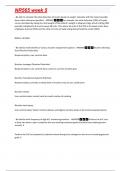NR565 week 5
- Be able to calculate the total daily dose of insulin based on weight. Calculate with the lowest possible
dose unless otherwise specified. - ANSWER✅✅✅For example, the total daily dose (TDD) of insulin
can be calculated by taking the total weight of the patient's weight in kilograms (kg), which is 80 kg (184
pounds) multiplied by 0.6 units equals 48 units. This means 24 units of the TDD is the basal insulin dose
of glargine (Lantus) (50%) and the other 24 units of rapid-acting bolus/mealtime insulin (50%).
80x0.6= 48 (tdd)
- Be familiar with benefits of various nicotine replacement options - ANSWER✅✅✅Nicotine Chewing
Gum (Nicotine Polacrilex):
Nonprescription; user controls dose
Nicotine Lozenges (Nicotine Polacrilex):
Nonprescription; user controls dose; easier to use than nicotine gum
Nicotine Transdermal Systems (Patches):
Nonprescription; provides a steady level of nicotine; easy to use; unobtrusive
Nicotine inhaler:
User controls dose; mimics hand-to-mouth motion of smoking
Nicotine nasal spray:
User controls dose; fastest nicotine delivery and highest nicotine levels of all nicotine-based products
- Be familiar with frequency of Hgb A1C monitoring timeline. - ANSWER✅✅✅Perform the A1C test
at least two times a year in patients who are meeting treatment goals (and who have stable glycemic
control). E
Perform the A1C test quarterly in patients whose therapy has changed or who are not meeting glycemic
goals. E
,NR565 week 5
Point-of-care testing for A1C provides the opportunity for more timely treatment changes. E
pg. 398
- Be familiar with metoclopramide's use, MOA, side effects, monitoring and patient teaching. -
ANSWER✅✅✅Metoclopramide (Reglan) has two beneficial actions: (1) it suppresses emesis (by
blocking receptors for dopamine and serotonin in the CTZ), and (2) it increases upper GI motility (by
enhancing the actions of acetylcholine).
Indications depend on the route (oral or intravenous). Oral metoclopramide has two approved uses:
diabetic gastroparesis and suppression of gastroesophageal reflux. Intravenous metoclopramide has
four approved uses: suppression of postoperative nausea and vomiting, suppression of CINV, facilitation
of small bowel intubation, and facilitation of radiologic examination of the GI tract. Off-label uses
include the treatment of hiccups and nausea and vomiting of early pregnancy.
Adverse Effects
With high-dose therapy, sedation and diarrhea are common. Long-term high-dose therapy can cause
irreversible tardive dyskinesia, characterized by repetitive, involuntary movements of the arms, legs,
and facial muscles. Older adults are especially vulnerable and can develop involuntary movement
disorders after a single dose. To reduce the risk for tardive dyskinesia, treatment should be as brief as
possible using the lowest effective dose. Owing to its ability to increase gastric and intestinal motility,
metoclopramide is contraindicated in patients with GI obstruction, perforation, or hemorrhage. Of note,
exposure to metoclopramide during the first trimester of pregnancy is not associated with an excess risk
for congenital malformations.
- Be familiar with roflumilast - Know when to use LABA, SABA, Combo drugs in COPD -
ANSWER✅✅✅One phosphodiesterase 4 (PDE4) inhibitor, Roflumilast (Daliresp. Daxas) is approved
for management of COPD. In patients with severe, chronic COPD with a primary chronic bronchitis
component, the risk for exacerbations may be reduced with this drug.
Mechanism of action.
Roflumilast is a selective inhibitor of PDE, an enzyme that inactivates cyclic adenosine monophosphate
(cAMP). By raising levels of cAMP in lung cells, the drug reduces inflammation by suppressing cytokine
release and by decreasing pulmonary infiltration by neutrophils and other white blood cells. As a result,
cough and excessive mucus production are reduced and mucociliary clearance is improved.
, NR565 week 5
Therapeutic use.
Romflumilast is approved only for management of COPD. It is not a first-line drug; rather, it is used for
exacerbation prophylaxis in patients with severe COPD with a primary chronic bronchitis component and
a history of frequent exacerbations.
Pharmacokinetics.
Romflumilast has a bioavailability approximating 80%. It peaks in approximately 1 hour, although this is
delayed if taken with food. It is 99% protein bound with a half-life of 17 hours. Metabolism to its active
metabolite is via CYP3A4 and CYP1A2 isoenzymes. Excretions is primarily through urine.
Adverse effects.
Adverse effects include diarrhea, reduced appetite, weight loss, nausea, headache, back pain, and
insomnia. It should be prescribed with caution for patients with depression. Safety in pregnancy has not
been established; however, adverse events occurred in animal reproduction studies. Breastfeeding is
not recommended when taking this drug. That being said, because COPD is uncommonly among women
of child-bearing age, this is not typically a concern.
- Be familiar with routine recommended vaccination schedules- not catch-up schedules -
ANSWER✅✅✅
- Be familiar with the rabies vaccination schedule. - ANSWER✅✅✅4 1-mL doses of HDCV or PCECV
IM. First dose ASAP after exposure (day 0), followed by days 3, 7, 14. Along with RIG (rabies immune
globulin).
If patient immunocompromised, 5 injections on days 0, 3, 7, 14, and 28.
Previous vaccine, 2 doses on day 0 and day 3 with no RIG.
- Be familiar with treatment algorithm for DM and when to increase or decrease insulin. -
ANSWER✅✅✅Slide 1:
The first-line treatment for all patients with diabetes is Metformin and lifestyle changes. Comprehensive
lifestyle management is key to improving health.




